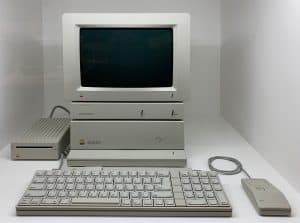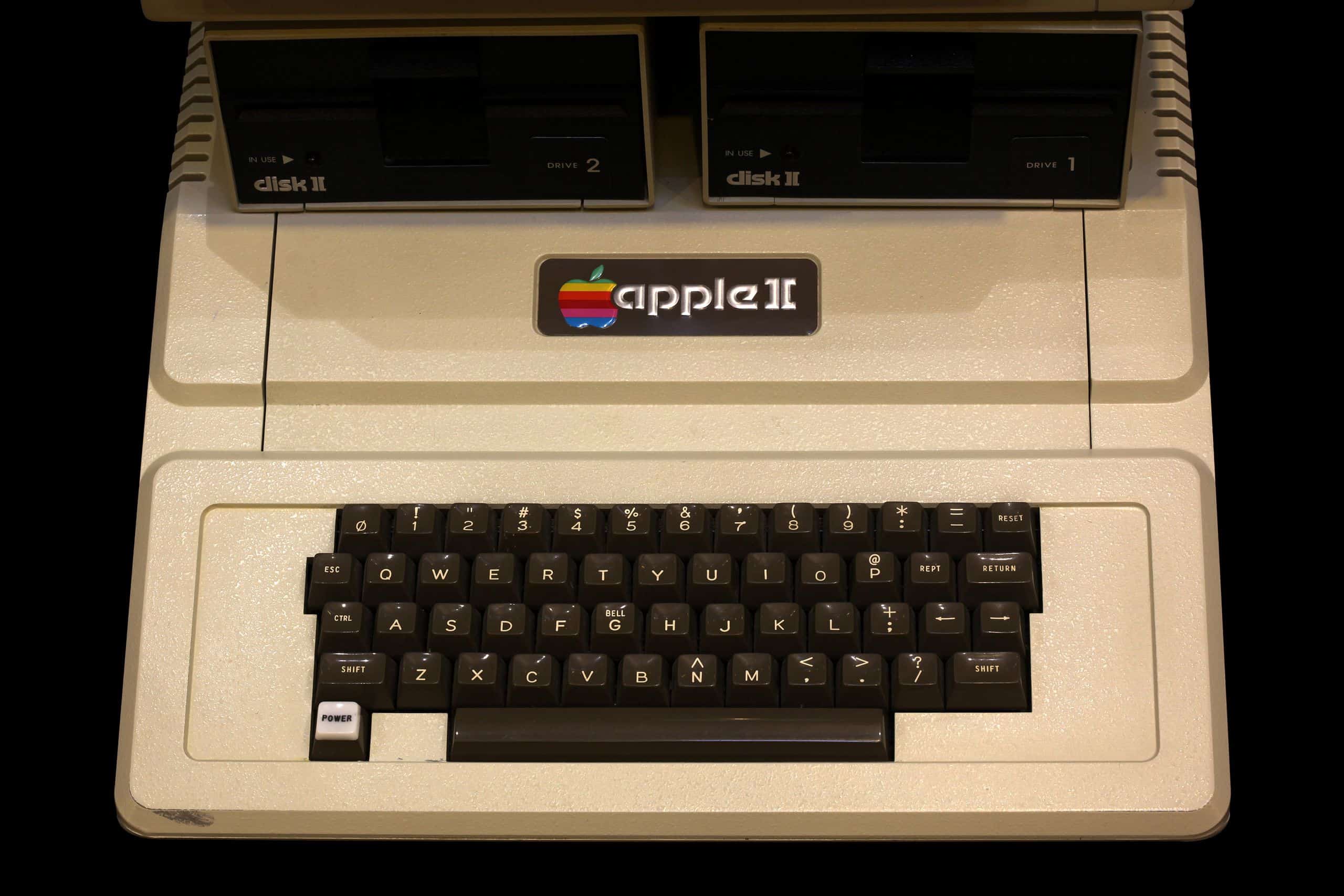Introduced to the world in 1977, the history of the Apple II is synonymous with Apple’s growth, success, and, ultimately, some of the troubles it dealt with early on in its history. A line of computers that essentially lived on until 1993, the Apple II may be one of the most important computers in the company’s history.
There is no question that this machine influenced the design and style of many other machines that followed and helped set Apple on a path that would give it enough life to see the iPod and iPhone developed and ultimately become the world’s most valuable brand.
Quick Facts
- Release Date
- 01/04/1977
- Original price
- $1298
- Discontinued
- 15/10/1993
- Units Sold
- 6000002
4 Facts About Apple II
- The Apple II’s central processor unit was based on a MOS 6502 CPU. It came with 4 KB of RAM, which could be increased to 48 KB. In addition, it came with a BASIC interpreter, the ability to support graphics and a color monitor.
- Apple first introduced external storage on cassette tape but later added an external floppy disc drive. The Apple II’s eight expansion slots on the motherboard were one of the most crucial features. These allowed consumers to add cards from Apple and several other vendors that immediately sprung up. The boards were floppy disc controllers, SCSI cards, video cards, and CP/M or PASCAL emulator cards.
- The video controller outputs NTSC composite video suitable for display on a TV monitor or a conventional TV set through a separate RF modulator, with 40 columns by 24 lines of upper-case-only, monochrome text on the screen.
- Software Arts released the first computer spreadsheet, Visicalc for this computer, in 1979. This “killer application” was immensely popular, resulting in many Apple II purchases. The laptop was improved and upgraded multiple times. Over 2 million computers had been sold when the Macintosh was released in 1984.
The Visual History of the Apple II
One of the most important computers in the history of Apple, the Apple II, may even be considered the company’s most important machine. As Modern Classic shows through its video, the history of the Apple II, which was the brainchild of Apple co-founder Steve Wozniak. Perhaps most interesting from the video is how the Apple II was a finished kit, unlike many other computers of the day, as it required no assembly.
However, the most engaging portion of the video is the backstory of the Apple II and how it came to fruition. Even more interesting is watching the growth of the Apple II line from one computer to many, including how Steve Jobs battled with introducing too many multimedia capabilities with the Apple II in an effort not to siphon sales from the Macintosh.
Apple II: Specs
Apple II was released in April 1977. The first computers had a MOS Technology 6502 microprocessor running at 1.022,727 MHz, two game paddles, 4 KiB of RAM, and an audio cassette interface for data storage and program loading. Wozniak’s design of Atari’s arcade video game Breakout (1976) influenced different aspects of the Apple II design.
The Apple II’s massive user base was a popular game development platform from the 1970s until the early 1990s. Some popular Apple II games include $100,000 Pyramid and 221B Baker Street. Its ROM was 12 kB, worth US$1,298 (equivalent to $5,543 in 2020).
The History of Apple II Computer: What to know
Stephen Gary “Woz” Wozniak (born August 11, 1950, in San Jose, California) is an American computer engineer and a legendary figure in the world of computers. The main reason for this remarkable recognition is the computer Apple II (often written as Apple ][). By the end of its production in 1993, somewhere between five and six million Apple II series computers (including approximately 1.25 million Apple IIGS models) had been produced.

Computer pioneers Steve Wozniak and Steve Jobs began selling their Apple I computer in kit form to computer retailers in 1976. In August of that year, Wozniak began designing an updated Apple II version. In December, Wozniak and Jobs presented a prototype. In 1977, Steve Wozniak designed the Apple II.
The self-contained machine had circuitry, a keyboard, a power source, and permanent memory for the BASIC language. The display was a television. Thanks to the floppy disc drive (1978) and the spreadsheet application VisiCalc (1979), it was a blockbuster. They eventually unveiled the Apple II to the public in April 1977. In the late 1970s, the Apple II sparked a surge in personal computer sales, propelling Apple to the forefront of the industry.
8-Bit Power
The computer was an 8-bit computer believed to be the pioneer of home microcomputers in the world. Steve Wozniak was principally responsible for its design; Steve Jobs directed the creation of the computer’s foam-molded plastic case, while Rod Holt created the switching power supply. Jobs and Wozniak launched it at the 1977 West Coast Computer Faire. It was Apple’s first consumer-oriented computer, aimed at American households rather than companies or commercial use.
Apple II was a project of Steve Wozniak and Steve Jobs. The prototype was made in December 1976 and sold on June 10, 1977. It became so popular that by the end of 1993, around five to six million Apple II series computers were produced, and then it was discontinued. Apple II was a leader in the first decade of personal computing because of its user-friendly design and graphical display. In addition, it was a finished consumer device, unlike the Apple I, which required customers to furnish critical pieces such as a case and power source.
Apple II Computer Versions: Each Edition

Many versions of Apple II computers were introduced, including the Apple II Plus, Apple IIc, Apple IIe, Apple IIGs, and Apple IIc plus. The Apple II was followed by the Apple II plus, discontinued in 1981. Over six million devices had been sold by 1984.
Apple II plus
This was the first version of Apple II that had many improvements. The II+ was virtually identical to the original II, except for better graphics and disk-booting capability in the ROM and the elimination of the 2k 6502 assembler/disassembler to make way for the floating-point BASIC. During 1980–81, RAM prices plummeted, and all II+ machines shipped with a full 48k of memory installed.
Apple IIe
The modified version, launched in 1983, has 64K RAM and a MOS 6502 or 65C02 CPU at 1 MHz. It was the most used and sold Apple II improved version. It is the longest-lived Apple computer, having been manufactured and marketed for nearly 11 years with minimal alterations.
Apple IIe was equipped with newer chips that were less expensive but more powerful. The IIe RAM was an Apple II Plus with a 48-KB RAM and a language card. The computer didn’t have a slot 0, but it did have an auxiliary slot that could receive a 1 KB memory card, allowing the 80-column display to work.
The Apple IIe had the hardware and firmware for the 80-column display, so this card merely had RAM. Thanks to an “extended 80-column card” with more memory, the machine’s RAM was upgraded to 128 KB.
Apple IIc
Launched in 1984, it was modified to have a built-in 5 1/4″ floppy disk drive, an MOS 65C02 CPU at 1.4 MHz, and 128K RAM. Because of its size and carrying handle, which could be flipped down to push the machine into a typing position, it was dubbed a portable Apple II.
Unlike modern portables, it lacked a built-in display and battery. It was the first of three Apple II models to feature the Snow White design language and the only one to feature the color’s distinctive creamy off-white hue. It had two different monochrome LCDs.
Apple IIGs
Western Digital 65C816 CPU at 2.8 MHz and 256K RAM. Launched in 1986, it had IIgs DOS operating system. It had a real 16-bit CPU, the 65C816, which ran at 2.8 MHz and had 24-bit addressing, allowing up to 8 MB of RAM to be added. In addition, it added a 4096-color palette and two graphics modes with resolutions of 320200 and 640400 pixels.
Apple IIc plus
Having improved RAM of 128K, MOS 65C02 CPU at 4 MHz was launched in 1988. The 5.25-inch floppy drive had been replaced with a 312-inch drive, the power supply had been moved within the casing, and the processor was a robust 4 MHz 65C02 processor that played 8-bit Apple II software quicker than the IIGS. In addition, the IIc Plus included a redesigned keyboard layout compatible with the Platinum IIe and IIGS.
The image featured at the top of this post is ©Rama / Creative Commons Attribution-Share Alike 2.0 France license.

